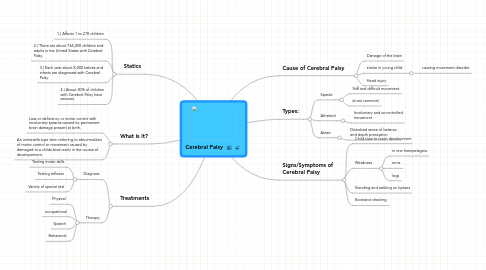Cerebral Palsy
by Racquel Dean


1. Statics
1.1. 1.) Affects 1 to 278 children
1.2. 2.) There are about 764,000 children and adults in the United States with Cerebral Palsy.
1.3. 3.) Each year about 8,000 babies and infants are diagnosed with Cerebral Palsy
1.4. 4.) About 30% of children with Cerebral Palsy have seizures.
2. Treatments
2.1. Diagnose
2.1.1. Testing motor skills
2.1.2. Testing reflexes
2.1.3. Variety of special test
2.2. Therapy
2.2.1. Physical
2.2.2. occupational
2.2.3. Speech
2.2.4. Behavorial
3. What is it?
3.1. Loss or deficiency or motor control with involuntary spasms caused by permanent brain damage present at birth.
3.2. An umberella type term referring to abnormalities of motor control or movement caused by damaged to a childs brain early in the course of developement.
4. Cause of Cerebral Palsy
4.1. Damage of the brain
4.2. stroke in young child.
4.2.1. causing movement disorder
4.3. Head injury
5. Signs/Symptoms of Cerebral Palsy
5.1. Child slow to reach development
5.2. Weakness
5.2.1. in one hemipelageia
5.2.2. arms
5.2.3. legs
5.3. Standing and walking on tiptoes
5.4. Excessive drooling
6. Types:
6.1. Spastic
6.1.1. Stiff and difficult movement.
6.1.2. (most common)
6.2. Athetoid
6.2.1. Involuntary and uncontrolled movement
6.3. Ataxic
6.3.1. Disturbed sense of balance and depth preception
